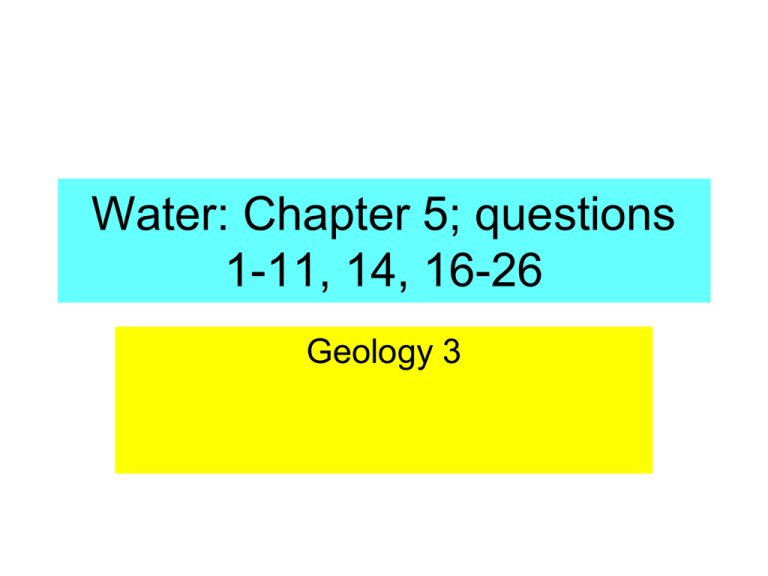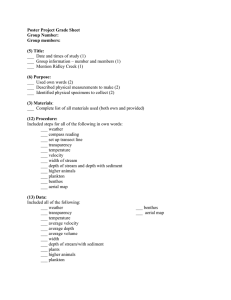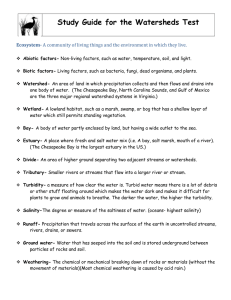Water: Chapter 5; questions 1-11, 14, 16-26 Geology 3
advertisement

Water: Chapter 5; questions 1-11, 14, 16-26 Geology 3 Hydrologic Cycle Freshwater 2.5% Atmosphere 0.001% Lakes and rivers 0.01% Oceans 97.5% Hydrosphere Ice caps and glaciers 1.8% Groundwater 0.63% Freshwater component (2.5% of total hydrosphere) Fig. 11.1, p.263 Streams: important agent of erosion and deposition Remove soil and bedrock Deposit sediments Alluvial fan, Death Valley Penitencia Creek, San Jose Erosion, sediment deposition, and sediment transport Drainage basin or water shed • All water from rain, runoff, drain systems empties into a river • Drainage divide separates one drainage basin from another Penitencia Creek is part of the Coyote Creek Watershed Coyote Creek Watershed The Continental Divide: runs through the Rocky Mountains To the Columbia River To the Colorado River To the Mississippi River Mississippi Water Basin Drains 2/3 of the U.S. into the Gulf of Mexico West of the Mississippi Columbia River Internal drainage Colorado River California’s water cycle • Rain shadow: orographic lifting • Precipitation (rain and snow) in the Sierra Nevada Klamath River drainage basin San Joaquin River drainage basin Sacramento River drainage basin Stream formation • Formation of a stream • Sheetwash of water • Water takes the path of least resistance Stream formation • Tributaries form and feed into the main channel Stream Valleys: headlands • • • • • Point of origin Highest elevation Steepest gradient Spring or narrow runoff channel Merge into larger tributary valleys Minnesota Stream valley: mouth or base level • The lowest level a stream can erode • Sea level is the ultimate base level • Lakes are temporary or local base levels Base Level: lowest level erosion can take place • San Francisco Bay is the base level for the San Joaquin and Sacramento Rivers • San Francisco Bay is an estuary (fresh water meets salt water) Breeding ground to many juvenile species Gradient: the slope of a stream • Feet per mile • If a stream descends 20 feet over a distance of 40 miles • 20/40 = 0.5 ft/mile Gradient Decreases from the headwaters to the base level (The Sierra Nevada to SF Bay) Velocity: determines the amount of erosion, transport, and deposition Fastest in center of channel Average: 3 miles/ hour Flood: 18 miles/hour Discharge: the amount of water passing a point on a stream Cubic feet or meters per second High discharge in California: Rainy season and snow melt Streams: Discharge • Increased discharge: – – – – Increases streams capacity-amount of sediment Increases the size of sediment moved (competence) Removes organic material Increases erosion Stream load: the amount of sediment that is transported Streams: transport sediment • Saltation- bouncing along bottom, larger size particles • Suspended load- clay • Dissolved ions- Explains why the sea is salty Streams • Natural channels have variations of water flow • Where the water is turbulent, the bedload is moved. • Where the water is quiet, smaller sediment is deposited River Systems • Transport sediments: move larger sizes of sediment in the upper portions; smaller size sediment in the lower portions Sierra Nevada Large size sediment: boulders and cobbles Central valley Sand and gravel San Francisco bay mud Streams: profile Streams: landforms-valleys • The upper portion of the stream generally produces well defined V-shaped valleys. • The Valley floor remains relatively clear of small size sediments. River Systems • Create landforms: V-shaped valleys in mountainous regions; Streams • Farther downstream • Channel is wider Stream Valleys • Broad valleys in lowlands (Salinas Valley) MEANDERING AND BRAIDED STREAMS Meandering Rivers Williams River, Alaska Meandering Rivers • • • • Outer bank erosion Inner bank: deposition Depth variations Velocity variations Meandering Rivers Streams: profile V-shaped valleys, large grain size, high energy Broad valleys, small grain size, lower energy, higher discharge Flood Plain • Flat area adjacent to river channel Flood Stage: high rain fall in a short amount of time or rapid snow melt • When discharge exceeds the channel’s capacity • Organic material is deposited on adjacent land • Natural levees are built up along the channel Egyptian Culture developed in association with the Nile’s cycle • Deposits organic-rich material in the broad valleys providing nutrients for vegetation • Egyptian culture developed around the Nile River’s cycle • Planting, harvesting and fishing • Flooding: time for other activities (art, building, reading and writing) Braided Streams • Large volume of sediment • Base of mountains New Zealand Alaska Bed load 30 million metric tons Dissolved load 120 million metric tons Suspended load 300 million metric tons Fig. 11.4, p.266 Riparian Corridor The land and native vegetation adjacent to the stream channel. Ranching Practices • Farming and ranching practices impact river systems • Adds sediment • Destroys natural vegetation or the riparian corridor Dams disrupt the natural flow of a stream Trinity River, California Adult Chinook salmon die in the lower Klamath River Alter stream flow and water temperature • Spawning gravels removed during high run-off, not replenished • Decreased flows • decrease velocity and capacity of system, riparian vegetation increases, decreasing locations for juvenile salmon Dams Benefits from dams Irrigation Reservoir storage Recreation Flood control Deltas • Sediment deposited at the base level • Velocity of stream decreases • Sediment is deposited Mississippi River Delta Velocity of river decreases, sediment is deposited Alluvial Fan • Velocity decreases when water leaves a confined area • Sediment is deposited The Delta: where fresh water meets salt water • Altered because of water use • Man-made levees Levee failure in June, 20?? Artificial Levees • Land subsides behind levees • If break occurs water will flood the lower area • After a flood, when discharge decreases, water is trapped behind the levee and cannot empty back into the stream Yolo Bypass •Flood control •Between Davis and Sacramento Areas left to flood as a natural process in the system •Environmentalists, farmers, and state agencies working together Groundwater: water collects between sediment grains or fractures in rocks Ground water • In 2000 165,000 acre feet was used – 1 acre foot = 1 football field with 1 foot of water – 2 families of 5 for one year – 326,000 gallons Ground water Upper limit of ground water Saturated zone: sediment completely filled with water Porosity: space between sediment grains Permeability: pores are connected allowing fluid to flow Ground water movement: is a response to gravity and areas of reduced pressure San Francisco Bay • River Valley during Ice Age • Collecting gravels (aquifer) Coastline was 22 miles west at the Farollon Islands • Estuary during warmer periods due to rise in sea level • Collecting muds (aquitard) Santa Clara Aquifer Cone of depression: where the water table lowers around a pumping well Artesian well: confined aquifer places water under pressure Subsidence • When too much water is extracted from the aquifer • Sediment compacts • Surface sinks Santa Clara Valley • About 4 meters (16 feet) of subsidence from 1900-1970 from extraction of groundwater Ground water contamination Salt Water Intrusion • Balance between recharge and discharge • The pressure of fresh water keeps the saltwater offshore • Extensive pumping lowers the pressure • Cone of depression • Inverted cone of depression- salt water will move to the well San Jose Waste Water Plant • 167,000 gallons of waste water/day • From homes, businesses and schools • Highest amount of fresh water in the southern San Francisco Bay San Jose Waste Water Plant • Santa Clara County’s sink, toilette water travels through underground pipes • May take ten hours to arrive • Eight hours later 99% of the impurities are gone Bottled Water • National Resources Defense Counsel • 4 year study • One-third of the bottled water tested contained levels of contamination • City tap water is subjected to more rigorous testing and purity standards Bottled Water • Plastic from17 million barrels of oil • Bottling the water produced more than 2.5 million tons of carbon dioxide • It took 3 liters of water to produce 1 liter of bottled water Domestic Water Use • 10% in the U.S. • 800 liters of water/day Domestic Water Use: less developed regions • World Health Organization: 20 liters/day • 1/6th of the global population lack this much water




